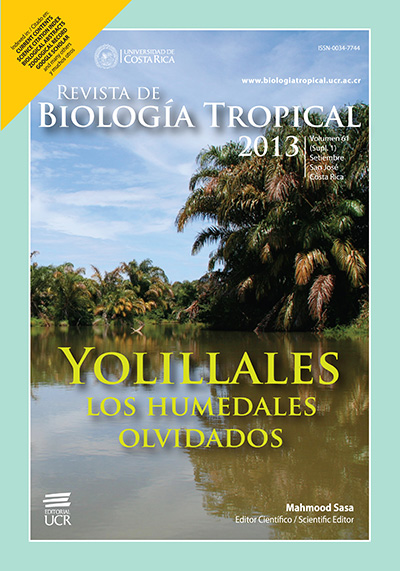Abstract
Here, I describe phenological activity of the raffia palm Raphia taedigera that dominates coastal swamps in northeastern Costa Rica. In this species, reproduction extends through the whole year, and it starts with the emergence and development of new inflorescences through the first month of the cycle. Expanded inflorescences develop into open flowers in a process that extends for three to four weeks to give rise to small fruits that are evidenced a month later. During the next twelve months or so, fruits mature but it take around six more months for all fruits to fall from the tree. Therefore, the entire reproductive process may exceed over two years. Different from other palm species, reproductive events in R. taedigera are aseasonal, and it is possible to observe palms in any reproductive state the whole year. Although the long period to fruit maturity exposes the seed to pre-dispersal losses, this disadvantage may be over weighted by the production of large and heavy seeds that mature at different times on the same inflorescence.
References
Baker, W.J., T.A. Hedderson & J. Dransfield. 2000. Molecular phylogenetics of subfamily Calamoideae (Palmae) Based on nrDNA ITS and cpDNA rps16 Intron Sequence Data. Mol. Phylogenet. Ev. 14: 195-217.
Brown, S. & A.E. Lugo. 1980. Preliminary estimate of the storage of organic carbon in tropical forest ecosystems, p. 65-117. In S. Brown, A.E. Lugo & B. Liegel (eds.). The role of tropical forest in the world carbon cycle. Nat. Tech. Inf. Serv. Springfield, Virginia, USA.
Golley, F.B., J. Ewel & G.I. Childs. 1976. Vegetation biomass of five ecosystems in northwestern Colombia. Trop. Ecol. 17: 16-22.
Henderson, A., G. Galeano & R. Bernal. 1995. Field Guide to the Palms of the Americas. Princeton University, Nueva Jersey, EE.UU.
Janzen, D.H. 1978. Seeding patterns of tropical tres. Tropical trees as living systems, Cambridge University, Cambridge, Reino Unido.
Lara-Vasquez, C.E. 2011. Fenología reproductiva y demografía de la palma Wettinia kalbreyeri (Burret) en un Bosque Alto-Andino de Colombia. Universidad Nacional de Colombia, Medellín, Colombia.
Moore, H.E. 1973. Palms in the tropical forest ecosystems of Africa and South America. Smithsonian Instn, Washington, EE.UU.
Myers, R.L. 1984. Growth form, growth characteristics and phenology of Raphia taedigera in Costa Rican palm swamps. Principes 28: 64-72.
Myers, R.L. 1990. Palm swamps, p. 267-286. In A.E. Lugo, M. Brinson & S. Brown (eds.). Forested wetlands. Elsevier Science, Amsterdam, Holanda.
Myers, R.L. 2013. Humedales dominados por palmas (Arecaceae) en el Neotrópico: Una introducción. Rev. Biol. Trop. 61 (Supl. 1): 5-24.
Schmid, R. 1970. Apuntes sobre la biología reproductiva de Asterogyne martiana (Palmae). I. Morfología de la inflorescencia y floral: fenología. II. Polinización por parte de moscas sírfidas. Principes. Vol. 14, no. 1-2 p. 3-9; 39-49.
Tomlinson, P.B. 1963. Measuring growth rates in palms. Principes 7: 40-44.
Tomlinson, P.B. 1979. Systematics and ecology of the Palmae. Annu. Rev. Ecol. Syst. 10: 85-107.
Uhl, N.W. & H.F. Moore Jr. 1977. Centrifugal stamen initiation in phytelephantoid palms. Am. J. Bot. 64: 1152-1161.

This work is licensed under a Creative Commons Attribution 4.0 International License.
Copyright (c) 2013 Revista de Biología Tropical

